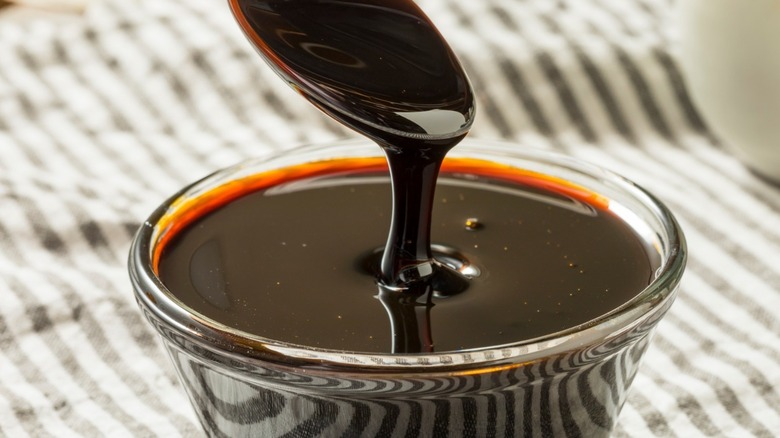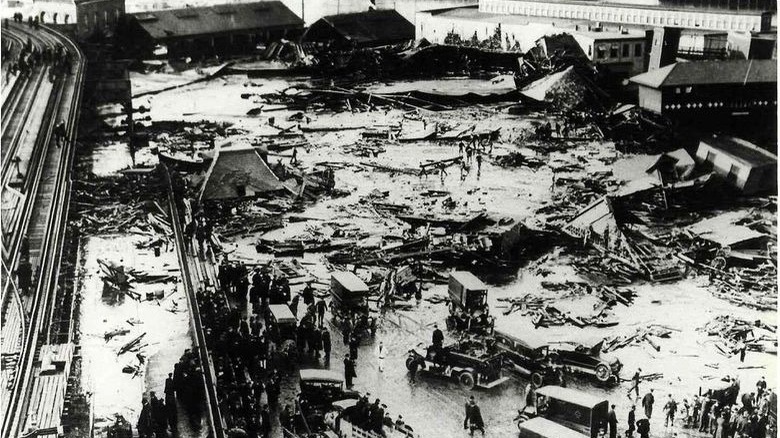How A Molasses Spill Turned Deadly In 20th Century Boston
When you hear the word "molasses," it likely conjures up images of yesteryear, of bakers in old-fashioned kitchens wearing their favorite frilly aprons, the family dog by their feet waiting to gobble up whatever morsels of food hit the floor. It's an ingredient that represents comfort and nostalgia. Some even choose to slather molasses on their pancakes instead of maple syrup. But while most people have encountered this deeply hued, sticky concoction, few know exactly what it is.
Molasses is a natural byproduct of the process of extracting sugar crystals from sugarcane and beets. It comes in either light, dark, or blackstrap depending on which part of the extraction process is underway. The blackstrap variety is the bitterest as it has the least amount of sugar. Molasses has many uses as it makes a great sweetener. It's the star of some baking recipes and goes perfectly with baked beans. No one would think of this seemingly benign syrup as a weapon of mass destruction, but on January 15, 1919, it was exactly that.
A giant molasses storage tank was built in Boston's north end
The Purity Distilling Company sat along the shores of Boston's North End. According to History, with the increasing need for explosives during World War I, the company's demand for molasses (a key ingredient in the production of industrial alcohol) grew significantly. As a result, they built a huge storage tank that could hold 2.5 million gallons of the dark, syrupy liquid, standing 50 feet high with a diameter of 90 feet (per Wired). To the average eye, this behemoth container didn't appear to pose a threat. There were, however, some tell-tale signs that the tank posed a serious problem.
Not only did it groan whenever workers topped it up, but there were also visible cracks that enabled children to fill their cups with the molasses that leaked out (per History). Purity Distilling Company's parent company, United States Industrial Alcohol, has been accused of neglecting to have an engineer or architect help develop the tank's plans for construction, failing to conduct regular quality inspections, and ignoring safety concerns (per Pacific Standard). Purity Distilling even painted the tank brown in an effort to hide the leaks from onlookers (per NBC News). It is believed that these failures were contributing factors to the impending disaster.
Several factors dangerously impacted the molasses tank
Some contend that weather transpired with the tank's faulty construction to bring about the horrible events of that winter day. The Weather Network purports that on January 15, 1919, the temperature rose dramatically from that of previous days and that the materials used to build the tank were "too brittle to handle the extreme change in temperatures." When the tank was filled with the warmed molasses (this was done to make it thinner and easier to transfer), and it encountered the cooler existing product, this may have been the last straw. This could have caused the contents to ferment.
History goes on to explain that molasses had been added to the tank 29 times, but only four of those fill-ups were near capacity. Two days before the disaster, 2.3 million gallons — enough to fill 3.5 Olympic-sized swimming pools — were added to the tank. And this massive volume of thick liquid was about to be unleashed upon an unsuspecting city and its citizens. Just after noon on that fateful day, the tank exploded.
The explosion took out entire city blocks
Immediately, a large piece of the container damaged a support of the elevated railway, causing the tracks to buckle as an approaching engineer managed to stop his train just in time. NBC News writes of the scene that followed, describing people being "swallowed, drowned, and asphyxiated by the viscous substance" as two city blocks were flooded in mere seconds. The liquid even tore a firehouse from its foundation and flung it into the harbor.
While molasses is notoriously a slow-pouring liquid, this scenario proved that under the right conditions it can move rapidly. As Nicole Sharp, an aerospace engineer, explains to History, "molasses — which is a non-Newtonian fluid like ketchup or toothpaste — would have moved as a gravity current, much like a mudslide, avalanche or lava flow." The syrup traveled at roughly 35 mph, taking out entire acres of land. One eyewitness account stated that within a mere minute, the streets were filled with a massive stream of the stuff (per Boston.com), and the Boston Post reported that horses "died like so many flies on sticky fly paper."
The molasses became thicker and slower as it traveled. NBC shares, "People were trapped, with witnesses described trying to breathe while stuck, gasping for their lives and simultaneously trying to avoid inhaling too much." By the day's end, 21 people were dead and 150 more were injured. Hauntingly, the sickly odor of molasses lingered for years to come.



